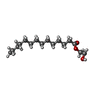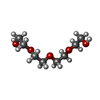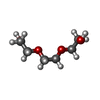[English] 日本語
 Yorodumi
Yorodumi- PDB-6uxr: Crystal structure of BAK core domain BH3-groove-dimer in complex ... -
+ Open data
Open data
- Basic information
Basic information
| Entry | Database: PDB / ID: 6uxr | ||||||||||||
|---|---|---|---|---|---|---|---|---|---|---|---|---|---|
| Title | Crystal structure of BAK core domain BH3-groove-dimer in complex with LysoPC | ||||||||||||
 Components Components | Bcl-2 homologous antagonist/killer | ||||||||||||
 Keywords Keywords | APOPTOSIS / Pore-forming Protein | ||||||||||||
| Function / homology |  Function and homology information Function and homology informationActivation and oligomerization of BAK protein / BH domain binding / B cell negative selection / BAK complex / negative regulation of endoplasmic reticulum calcium ion concentration / response to fungus / response to mycotoxin / limb morphogenesis / Release of apoptotic factors from the mitochondria / apoptotic process involved in blood vessel morphogenesis ...Activation and oligomerization of BAK protein / BH domain binding / B cell negative selection / BAK complex / negative regulation of endoplasmic reticulum calcium ion concentration / response to fungus / response to mycotoxin / limb morphogenesis / Release of apoptotic factors from the mitochondria / apoptotic process involved in blood vessel morphogenesis / post-embryonic camera-type eye morphogenesis / endocrine pancreas development / establishment or maintenance of transmembrane electrochemical gradient / B cell apoptotic process / negative regulation of mitochondrial outer membrane permeabilization involved in apoptotic signaling pathway / positive regulation of mitochondrial outer membrane permeabilization involved in apoptotic signaling pathway / endoplasmic reticulum calcium ion homeostasis / regulation of mitochondrial membrane permeability / calcium ion transport into cytosol / fibroblast apoptotic process / response to UV-C / mitochondrial fusion / Bcl-2 family protein complex / myeloid cell homeostasis / porin activity / thymocyte apoptotic process / negative regulation of release of cytochrome c from mitochondria / pore complex / positive regulation of IRE1-mediated unfolded protein response / positive regulation of release of cytochrome c from mitochondria / vagina development / B cell homeostasis / positive regulation of calcium ion transport into cytosol / positive regulation of proteolysis / intrinsic apoptotic signaling pathway in response to endoplasmic reticulum stress / blood vessel remodeling / animal organ regeneration / cellular response to unfolded protein / Pyroptosis / heat shock protein binding / extrinsic apoptotic signaling pathway in absence of ligand / intrinsic apoptotic signaling pathway / release of cytochrome c from mitochondria / epithelial cell proliferation / response to gamma radiation / regulation of mitochondrial membrane potential / apoptotic signaling pathway / positive regulation of protein-containing complex assembly / response to hydrogen peroxide / establishment of localization in cell / cellular response to mechanical stimulus / intrinsic apoptotic signaling pathway in response to DNA damage / cellular response to UV / protein-folding chaperone binding / channel activity / response to ethanol / transmembrane transporter binding / mitochondrial outer membrane / regulation of cell cycle / positive regulation of apoptotic process / response to xenobiotic stimulus / protein heterodimerization activity / negative regulation of cell population proliferation / negative regulation of gene expression / apoptotic process / protein-containing complex binding / endoplasmic reticulum / protein homodimerization activity / mitochondrion / metal ion binding / identical protein binding / cytosol Similarity search - Function | ||||||||||||
| Biological species |  Homo sapiens (human) Homo sapiens (human) | ||||||||||||
| Method |  X-RAY DIFFRACTION / X-RAY DIFFRACTION /  SYNCHROTRON / SYNCHROTRON /  MOLECULAR REPLACEMENT / MOLECULAR REPLACEMENT /  molecular replacement / Resolution: 1.8 Å molecular replacement / Resolution: 1.8 Å | ||||||||||||
 Authors Authors | Cowan, A.D. / Colman, P.M. / Czabotar, P.E. | ||||||||||||
| Funding support |  Australia, 3items Australia, 3items
| ||||||||||||
 Citation Citation |  Journal: Nat.Struct.Mol.Biol. / Year: 2020 Journal: Nat.Struct.Mol.Biol. / Year: 2020Title: BAK core dimers bind lipids and can be bridged by them. Authors: Cowan, A.D. / Smith, N.A. / Sandow, J.J. / Kapp, E.A. / Rustam, Y.H. / Murphy, J.M. / Brouwer, J.M. / Bernardini, J.P. / Roy, M.J. / Wardak, A.Z. / Tan, I.K. / Webb, A.I. / Gulbis, J.M. / ...Authors: Cowan, A.D. / Smith, N.A. / Sandow, J.J. / Kapp, E.A. / Rustam, Y.H. / Murphy, J.M. / Brouwer, J.M. / Bernardini, J.P. / Roy, M.J. / Wardak, A.Z. / Tan, I.K. / Webb, A.I. / Gulbis, J.M. / Smith, B.J. / Reid, G.E. / Dewson, G. / Colman, P.M. / Czabotar, P.E. | ||||||||||||
| History |
|
- Structure visualization
Structure visualization
| Structure viewer | Molecule:  Molmil Molmil Jmol/JSmol Jmol/JSmol |
|---|
- Downloads & links
Downloads & links
- Download
Download
| PDBx/mmCIF format |  6uxr.cif.gz 6uxr.cif.gz | 87.6 KB | Display |  PDBx/mmCIF format PDBx/mmCIF format |
|---|---|---|---|---|
| PDB format |  pdb6uxr.ent.gz pdb6uxr.ent.gz | 64.1 KB | Display |  PDB format PDB format |
| PDBx/mmJSON format |  6uxr.json.gz 6uxr.json.gz | Tree view |  PDBx/mmJSON format PDBx/mmJSON format | |
| Others |  Other downloads Other downloads |
-Validation report
| Summary document |  6uxr_validation.pdf.gz 6uxr_validation.pdf.gz | 329.2 KB | Display |  wwPDB validaton report wwPDB validaton report |
|---|---|---|---|---|
| Full document |  6uxr_full_validation.pdf.gz 6uxr_full_validation.pdf.gz | 330.6 KB | Display | |
| Data in XML |  6uxr_validation.xml.gz 6uxr_validation.xml.gz | 1.7 KB | Display | |
| Data in CIF |  6uxr_validation.cif.gz 6uxr_validation.cif.gz | 3.8 KB | Display | |
| Arichive directory |  https://data.pdbj.org/pub/pdb/validation_reports/ux/6uxr https://data.pdbj.org/pub/pdb/validation_reports/ux/6uxr ftp://data.pdbj.org/pub/pdb/validation_reports/ux/6uxr ftp://data.pdbj.org/pub/pdb/validation_reports/ux/6uxr | HTTPS FTP |
-Related structure data
| Related structure data | 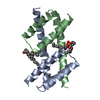 6uxmC  6uxnC 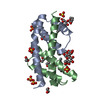 6uxoSC 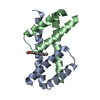 6uxpC 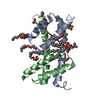 6uxqC S: Starting model for refinement C: citing same article ( |
|---|---|
| Similar structure data |
- Links
Links
- Assembly
Assembly
| Deposited unit | 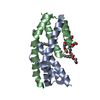
| ||||||||
|---|---|---|---|---|---|---|---|---|---|
| 1 |
| ||||||||
| Unit cell |
|
- Components
Components
| #1: Protein | Mass: 9500.688 Da / Num. of mol.: 2 / Fragment: Core/dimerisation domain, residues 68-148 Source method: isolated from a genetically manipulated source Source: (gene. exp.)  Homo sapiens (human) / Gene: BAK1, BAK, BCL2L7, CDN1 / Plasmid: pGEX-6P-3 / Production host: Homo sapiens (human) / Gene: BAK1, BAK, BCL2L7, CDN1 / Plasmid: pGEX-6P-3 / Production host:  #2: Chemical | #3: Chemical | ChemComp-PG4 / | #4: Chemical | ChemComp-PGE / #5: Water | ChemComp-HOH / | Has ligand of interest | Y | |
|---|
-Experimental details
-Experiment
| Experiment | Method:  X-RAY DIFFRACTION / Number of used crystals: 1 X-RAY DIFFRACTION / Number of used crystals: 1 |
|---|
- Sample preparation
Sample preparation
| Crystal | Density Matthews: 2.57 Å3/Da / Density % sol: 52.08 % |
|---|---|
| Crystal grow | Temperature: 293 K / Method: vapor diffusion, sitting drop / pH: 7.5 Details: calcium chloride, PEG 3350, sodium acetate, sodium HEPES |
-Data collection
| Diffraction | Mean temperature: 100 K / Serial crystal experiment: N | ||||||||||||||||||||||||||||||||||||||||||||||||||||||||||||||||||||||||||||||||||||||||||||||||||||
|---|---|---|---|---|---|---|---|---|---|---|---|---|---|---|---|---|---|---|---|---|---|---|---|---|---|---|---|---|---|---|---|---|---|---|---|---|---|---|---|---|---|---|---|---|---|---|---|---|---|---|---|---|---|---|---|---|---|---|---|---|---|---|---|---|---|---|---|---|---|---|---|---|---|---|---|---|---|---|---|---|---|---|---|---|---|---|---|---|---|---|---|---|---|---|---|---|---|---|---|---|---|
| Diffraction source | Source:  SYNCHROTRON / Site: SYNCHROTRON / Site:  Australian Synchrotron Australian Synchrotron  / Beamline: MX2 / Wavelength: 0.9537 Å / Beamline: MX2 / Wavelength: 0.9537 Å | ||||||||||||||||||||||||||||||||||||||||||||||||||||||||||||||||||||||||||||||||||||||||||||||||||||
| Detector | Type: ADSC QUANTUM 315r / Detector: CCD / Date: Apr 19, 2016 | ||||||||||||||||||||||||||||||||||||||||||||||||||||||||||||||||||||||||||||||||||||||||||||||||||||
| Radiation | Protocol: SINGLE WAVELENGTH / Monochromatic (M) / Laue (L): M / Scattering type: x-ray | ||||||||||||||||||||||||||||||||||||||||||||||||||||||||||||||||||||||||||||||||||||||||||||||||||||
| Radiation wavelength | Wavelength: 0.9537 Å / Relative weight: 1 | ||||||||||||||||||||||||||||||||||||||||||||||||||||||||||||||||||||||||||||||||||||||||||||||||||||
| Reflection | Resolution: 1.8→30.041 Å / Num. obs: 18448 / % possible obs: 99.7 % / Redundancy: 14.493 % / Biso Wilson estimate: 44.11 Å2 / CC1/2: 1 / Rmerge(I) obs: 0.059 / Rrim(I) all: 0.061 / Χ2: 0.916 / Net I/σ(I): 28.1 / Num. measured all: 267375 | ||||||||||||||||||||||||||||||||||||||||||||||||||||||||||||||||||||||||||||||||||||||||||||||||||||
| Reflection shell | Diffraction-ID: 1
|
-Phasing
| Phasing | Method:  molecular replacement molecular replacement | |||||||||
|---|---|---|---|---|---|---|---|---|---|---|
| Phasing MR |
|
- Processing
Processing
| Software |
| |||||||||||||||||||||||||||||||||||||||||||||||||||||||||||||||||||||||||||||||||||||||||||||||||||||||||||||||||||||||||||||
|---|---|---|---|---|---|---|---|---|---|---|---|---|---|---|---|---|---|---|---|---|---|---|---|---|---|---|---|---|---|---|---|---|---|---|---|---|---|---|---|---|---|---|---|---|---|---|---|---|---|---|---|---|---|---|---|---|---|---|---|---|---|---|---|---|---|---|---|---|---|---|---|---|---|---|---|---|---|---|---|---|---|---|---|---|---|---|---|---|---|---|---|---|---|---|---|---|---|---|---|---|---|---|---|---|---|---|---|---|---|---|---|---|---|---|---|---|---|---|---|---|---|---|---|---|---|---|
| Refinement | Method to determine structure:  MOLECULAR REPLACEMENT MOLECULAR REPLACEMENTStarting model: 6UXO Resolution: 1.8→30.041 Å / SU ML: 0.33 / Cross valid method: THROUGHOUT / σ(F): 1.34 / Phase error: 27.55 / Stereochemistry target values: ML
| |||||||||||||||||||||||||||||||||||||||||||||||||||||||||||||||||||||||||||||||||||||||||||||||||||||||||||||||||||||||||||||
| Solvent computation | Shrinkage radii: 0.9 Å / VDW probe radii: 1.11 Å / Solvent model: FLAT BULK SOLVENT MODEL | |||||||||||||||||||||||||||||||||||||||||||||||||||||||||||||||||||||||||||||||||||||||||||||||||||||||||||||||||||||||||||||
| Displacement parameters | Biso max: 122.66 Å2 / Biso mean: 55.5178 Å2 / Biso min: 25.95 Å2 | |||||||||||||||||||||||||||||||||||||||||||||||||||||||||||||||||||||||||||||||||||||||||||||||||||||||||||||||||||||||||||||
| Refinement step | Cycle: final / Resolution: 1.8→30.041 Å
| |||||||||||||||||||||||||||||||||||||||||||||||||||||||||||||||||||||||||||||||||||||||||||||||||||||||||||||||||||||||||||||
| LS refinement shell | Refine-ID: X-RAY DIFFRACTION / Rfactor Rfree error: 0
| |||||||||||||||||||||||||||||||||||||||||||||||||||||||||||||||||||||||||||||||||||||||||||||||||||||||||||||||||||||||||||||
| Refinement TLS params. | Method: refined / Refine-ID: X-RAY DIFFRACTION
| |||||||||||||||||||||||||||||||||||||||||||||||||||||||||||||||||||||||||||||||||||||||||||||||||||||||||||||||||||||||||||||
| Refinement TLS group |
|
 Movie
Movie Controller
Controller


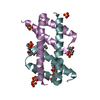
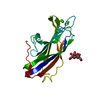
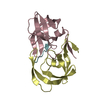
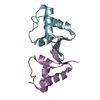
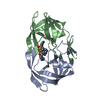

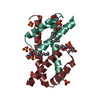
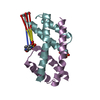
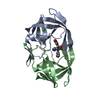
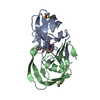
 PDBj
PDBj








